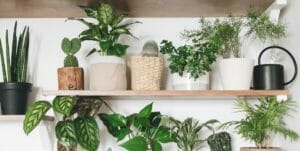Keeping your plants alive in the winter is no easy task. Many days the sun never makes it out. Setting plants by the window might work during other seasons, but what about those cold windows and drafts in the winter? Well our team at Stone Creek Landscaping did some research and found a fantastic article about keeping your plants alive in the winter. We found a great post at Urban Leaf and wanted to share it with you all.*
1. Keep Your Plants Warm – But Not Too Warm
Many plants are extremely sensitive to cold air. The #1 step to caring for houseplants in winter is to make sure they are protected from the cold air. You can partly solve this by sealing up your windows and insulating the doors of your home. Also, if you keep plants next to outside doors or leaky windowsills during the warmer months, make sure you move them to other rooms where they won’t get shocked by the cold air.
You also want to make sure you keep plants away from sources of heat, like fireplaces, radiators, and even heating vents. Blasts of hot air can be just as bad for your plant as blasts of cold air. Keep your plants at a steady temperature between 65-75 degrees F (18 – 24 C) during the day, and above 50 degrees F (10 C) at night for the best plant living conditions.
2. Reduce Your Watering And Use Warm Water For Plants In Winter
Even though your plants are inside, the majority of houseplants go ‘dormant’ in the fall and winter months. Less light means less growth, and less growth means they need less water and fertilizer. This can also mean less feeding for your indoor plants in winter.
Follow standard watering advice, and only water if the soil is dry an inch or two below the surface. You want to make sure your plants don’t stay sitting in water because that can lead to root rot, fungus, mold, and a host of other issues. If you see yellow leaves or moldy soil, then you’ll know you need to reduce your watering frequency. You may also want to use warm water for your plants in winter. Watering plants with warm water in winter is better as not only it helps the plants grow faster and larger, it will also keep them warm.
Most houseplant owners will use a ‘once per week’ schedule for watering – and we recommend you keep this up for consistency’s sake and so that you don’t break the rhythm. But just reduce the amount of water you provide, by somewhere in the 25-50% range, on your weekly watering days.
3. Increase Your Home’s Humidity
Low humidity in the cold months isn’t just a problem for people – it’s a problem for plants, too. Plants enjoy humidity levels around 50 – 60%, so keep your humidifier running if you have one. If you don’t, try clustering your plants together in the most humid rooms of your home (typically the bathrooms or kitchen), or placing them on top of a large tray or baking sheet filled with water. (You just have to make sure the pots don’t touch the water, so place some stones in the water and put the plants on top of the stones.)

4. Clean Your Plants
Sun is in short supply in the winter. To make sure they can take full advantage of the little light they have, make sure your indoor plants’ leaves stay clean and dust-free. Every couple of weeks, put your plants in the bathtub and use a handheld sprayer to give the leaves a gentle shower, or use a damp towel to wipe dust and grime off the leaves. Keeping the leaves clean means, they can be more efficient at photosynthesis.
5. Give Them Plenty Of Light
The last answer on how to keep your indoor plants alive is that plants need light more than anything else in the fall and winter. You will need to be extra careful to rotate your pots to make sure each plant is getting the sunlight they need. If the available natural sunlight isn’t enough, use a full-spectrum lightbulb in a standard desk lamp and shine it on your plants for at least 12-14 hours a day. Learn more about setting up a grow lamp, or purchase an LED grow light in our store.
As a final tip, it pays to keep in mind that some of the recommendations we’re making in this article involve changing multiple variables – for example, if you move your plants away from a drafty window, you will almost certainly be changing the amount of light it gets – perhaps also the humidity is changing at the same time too. For this reason, monitor your plants daily after they have been relocated – some changes may need to be reversed, or you might need to do some trial and error to get it right.
*Source Urban Leaf
